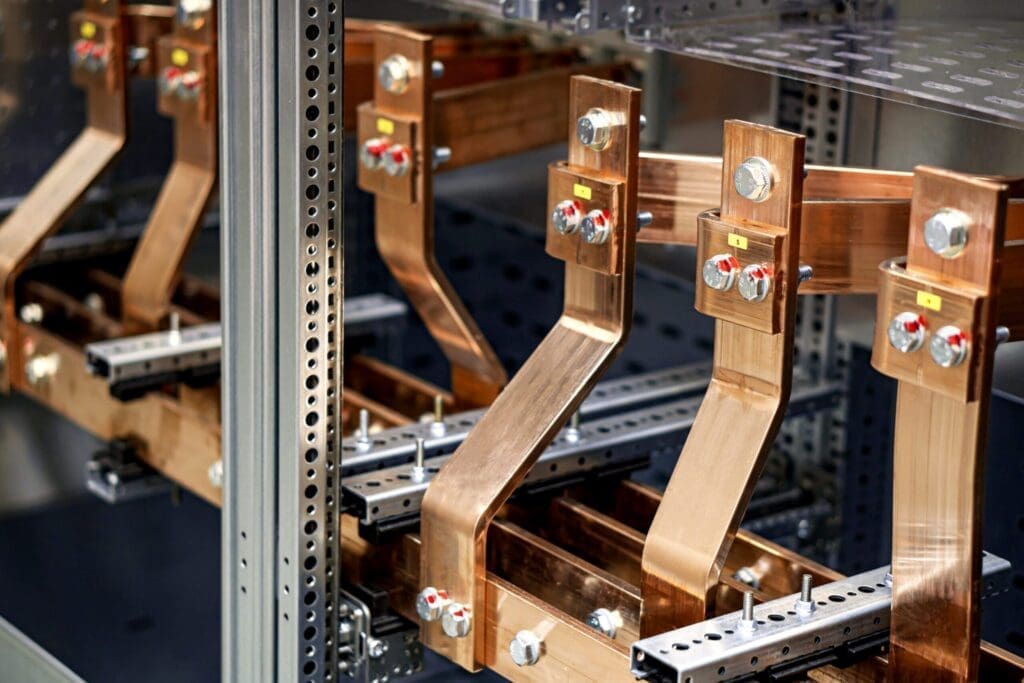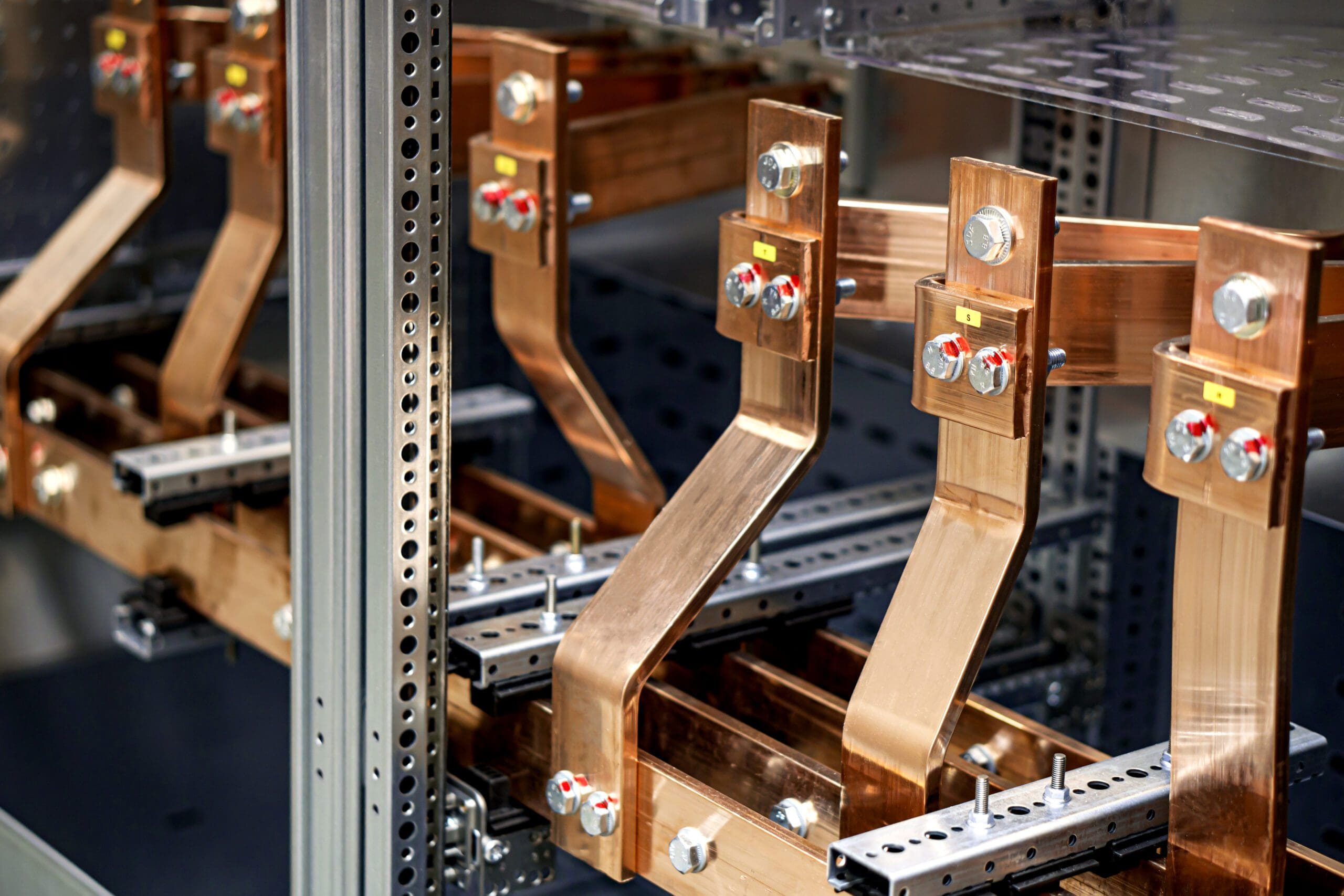A busbar is a metallic strip or bar used for power distribution in electrical systems. It efficiently conducts electricity within switchboards, distribution boards, and substations.
Busbars play a crucial role in electrical power distribution. They are typically made of copper or aluminum due to their excellent conductivity. These bars or strips simplify the complex wiring in electrical systems, enhancing efficiency and safety. Engineers use busbars to centralize and organize multiple electrical connections, ensuring stable power distribution.
They are integral in various settings, including residential, commercial, and industrial applications. Properly designed busbars help minimize energy loss and reduce maintenance costs. Their robustness and reliability make them essential for modern electrical infrastructure. Understanding busbars can lead to better energy management and safer electrical installations.
Introduction To Busbars
Busbars play a crucial role in electrical systems. They help in power distribution efficiently. Understanding busbars is essential for anyone in the electrical field.
What Is A Busbar?
A busbar is a metallic strip or bar. It conducts electricity within a switchboard, distribution board, or other electrical apparatus. Busbars are made of copper, brass, or aluminum. They are used for high current applications.
| Material | Usage |
|---|---|
| Copper | High conductivity |
| Brass | Corrosion resistance |
| Aluminum | Cost-effective |
History And Evolution
The history of busbars dates back to early electrical engineering. They were first used in the late 19th century. Over time, their design and materials have evolved.
- Late 19th century: Basic copper busbars
- Mid 20th century: Introduction of aluminum busbars
- Modern times: Advanced materials and designs
Modern busbars are more efficient and reliable. They have better insulation and cooling mechanisms. This evolution has improved power distribution systems globally.
Types Of Busbars
Busbars are crucial in electrical systems. They distribute power efficiently. Various types of busbars exist. Each type has unique features and benefits.
Copper Vs. Aluminum
Busbars are made from copper or aluminum. Each material has distinct advantages.
| Feature | Copper Busbars | Aluminum Busbars |
|---|---|---|
| Conductivity | Higher conductivity | Lower conductivity |
| Durability | More durable | Less durable |
| Weight | Heavier | Lighter |
| Cost | More expensive | Less expensive |
Insulated Vs. Non-insulated
Busbars can be insulated or non-insulated. Each type serves a purpose.
- Insulated Busbars
- Covered with insulating material
- Prevent accidental contact
- Ideal for compact spaces
- Non-Insulated Busbars
- No insulating cover
- Require careful installation
- Used in open and controlled environments
Design And Construction
The design and construction of busbars are crucial in electrical systems. Their efficiency and reliability depend on the materials and processes used.
Material Selection
Choosing the right material for busbars is vital. Common materials include copper and aluminum. Each offers unique benefits.
Copper is a popular choice. It has high electrical conductivity. It also resists oxidation and corrosion.
Aluminum is another option. It’s lightweight and cost-effective. Though less conductive than copper, it is still efficient.
| Material | Benefits |
|---|---|
| Copper | High conductivity, corrosion resistance |
| Aluminum | Lightweight, cost-effective |
Manufacturing Processes
Busbars undergo several manufacturing processes. These ensure they meet safety and performance standards.
- Cutting: The material is cut to the desired length.
- Bending: The busbar is bent into shape. This process ensures a perfect fit.
- Drilling: Holes are drilled for connections. This step is crucial for mounting.
- Plating: The busbar is coated. This adds a protective layer.
These steps ensure the busbar is ready for use. Each step is essential for quality and durability.
Credit: www.chatsworth.com
Applications In Various Industries
Busbars are essential in many industries. They distribute power efficiently. Let’s explore their applications in various sectors.
Automotive Industry
Busbars play a key role in the automotive industry. They are crucial in electric vehicles. Busbars provide high currents to the motors. This ensures efficient power distribution.
- Reduces wiring complexity
- Enhances energy efficiency
- Improves overall performance
Manufacturers use busbars in battery packs. They connect cells safely and efficiently. This ensures the vehicle runs smoothly.
Power Plants
In power plants, busbars are vital. They handle large amounts of electricity. This helps in distributing power to different areas.
| Benefit | Description |
|---|---|
| Enhanced Safety | Reduces electrical hazards |
| High Efficiency | Minimizes power loss |
| Reliability | Ensures continuous power supply |
Busbars are also used in switchgear. This makes them essential for power distribution systems.
Data Centers
Data centers rely heavily on busbars. They provide a stable power supply to servers. This ensures data centers operate smoothly.
- Reduces downtime
- Increases system reliability
- Optimizes power usage
Busbars also help in cooling systems. They reduce heat generated by electrical connections. This keeps data centers cool and efficient.
In summary, busbars are indispensable in various industries. They ensure efficient power distribution and safety.
Benefits Of Using Busbars
Busbars are crucial in power distribution. They offer many benefits. Learn about enhanced efficiency, reduced space, and improved safety.
Enhanced Efficiency
Busbars enhance efficiency by reducing energy loss. They have low resistance. This results in minimal power loss.
They also support higher current loads. This makes them ideal for large systems.
Busbars distribute electricity evenly. This ensures stable and reliable power.
Reduced Space
Busbars save space in electrical panels. They replace bulky wiring. This allows for compact designs.
They are easy to install. This reduces the need for complex wiring systems.
Busbars create neat and organized layouts. This helps in managing electrical systems better.
Improved Safety
Busbars improve safety in electrical systems. They are insulated. This reduces the risk of electrical shocks.
They have high thermal stability. This prevents overheating and fires.
Busbars are durable and reliable. This ensures long-term safety and performance.

Credit: en.wikipedia.org
Installation And Maintenance
Installing and maintaining busbars is crucial for electrical systems. Proper installation ensures efficiency and safety. Regular maintenance extends the lifespan of busbars. Below are the guidelines and tips for both.
Installation Guidelines
Follow these guidelines to ensure a safe and efficient installation:
- Preparation: Inspect the installation site. Ensure it is clean and dry.
- Safety Gear: Wear appropriate safety gear. This includes gloves and goggles.
- Tools: Use the correct tools. This ensures proper handling and fitting.
- Layout: Mark the layout on the installation surface. This aids in precise placement.
- Mounting: Securely mount the busbars. Use brackets or support structures.
- Connections: Make connections tight. Loose connections can lead to overheating.
- Inspection: Inspect all connections. Ensure there are no loose ends.
Maintenance Tips
Regular maintenance ensures the longevity and efficiency of busbars:
- Visual Checks: Regularly inspect for wear and tear.
- Thermal Scanning: Use thermal imaging to detect hot spots.
- Cleaning: Clean busbars with a dry cloth. Avoid water and chemicals.
- Tightening: Check and tighten all connections periodically.
- Corrosion: Look for signs of corrosion. Treat immediately if found.
- Insulation: Inspect insulation. Replace if damaged.
Remember, proper installation and maintenance of busbars ensure safety and efficiency.
Challenges And Solutions
Busbars are critical components in electrical systems. They distribute power efficiently and reliably. However, they face several challenges that can impact performance and safety. Understanding these challenges and finding solutions is crucial.
Common Issues
Busbars often encounter various problems. Here are some common issues:
- Overheating: Excessive current can cause overheating.
- Corrosion: Exposure to moisture can lead to corrosion.
- Mechanical Stress: Vibrations can cause mechanical stress and damage.
- Electrical Faults: Short circuits can occur due to faults.
- Improper Installation: Incorrect installation can lead to inefficiency and danger.
Innovative Solutions
To tackle these issues, various innovative solutions have been developed:
- Cooling Systems: Implementing advanced cooling systems helps manage overheating.
- Protective Coatings: Applying protective coatings can prevent corrosion.
- Flexible Connectors: Using flexible connectors reduces mechanical stress.
- Fault Detection Systems: Advanced fault detection systems can identify and mitigate electrical faults.
- Proper Training: Ensuring proper training for installation helps prevent errors.
| Issue | Solution |
|---|---|
| Overheating | Advanced Cooling Systems |
| Corrosion | Protective Coatings |
| Mechanical Stress | Flexible Connectors |
| Electrical Faults | Fault Detection Systems |
| Improper Installation | Proper Training |
Future Trends
The future of Busbar technology is bright, with many exciting trends emerging. From technological advancements to market growth predictions, the landscape is rapidly evolving. Below, we delve into some key trends shaping the future of busbars.
Technological Advancements
New materials are making busbars more efficient and durable. Copper and aluminum are being optimized for better conductivity and heat resistance. Engineers are focusing on flexible busbars that fit into tight spaces. This helps in modern electronics where space-saving is crucial.
Another major trend is automation. Automated manufacturing processes ensure higher precision and consistency. This reduces errors and production costs. Smart busbars are also gaining traction. These busbars can monitor their own performance and send alerts if issues arise. This leads to higher reliability and lower maintenance costs.
Market Growth Predictions
The busbar market is poised for significant growth. Analysts predict a strong increase in demand over the next decade. This is driven by the rise of renewable energy sources. Solar and wind power systems often require efficient busbars for power distribution.
Electric vehicles (EVs) are another major driver. As EV adoption increases, so does the need for efficient busbars. The push for smart grids also fuels market growth. Smart grids require advanced busbar systems for optimal performance.
| Sector | Growth Rate |
|---|---|
| Renewable Energy | 8% annually |
| Electric Vehicles | 10% annually |
| Smart Grids | 12% annually |
In summary, the future of busbars is promising. Technological advancements and market growth predictions point to a robust future. Stay tuned for more updates on this dynamic industry.
Case Studies
Exploring real-world applications helps understand the power and versatility of busbars. This section delves into various case studies showcasing successful implementations and lessons learned.
Successful Implementations
Busbars have been utilized in numerous projects with outstanding success. Below are some remarkable examples:
- Data Centers: Enhanced power distribution and reduced downtime.
- Industrial Plants: Improved efficiency and safety in power management.
- Renewable Energy: Optimized connections in solar and wind farms.
| Project | Industry | Outcome |
|---|---|---|
| GreenTech Solar Farm | Renewable Energy | Increased energy output by 20% |
| Alpha Data Center | IT | Reduced power outages by 30% |
| Omega Manufacturing Plant | Industrial | Enhanced operational efficiency by 25% |
Lessons Learned
Every project provides valuable insights. Here are key takeaways from various implementations:
- Proper Planning: Ensure detailed design and layout planning.
- Quality Materials: Use high-quality materials to avoid failures.
- Regular Maintenance: Schedule regular checks to maintain performance.
These lessons highlight the importance of meticulous planning, quality assurance, and maintenance in busbar systems.

Credit: www.approvedsheetmetal.com
Frequently Asked Questions
What Is A Busbar?
A busbar is a metallic strip or bar. It distributes electrical power within a system. It provides a convenient way to connect multiple circuits.
Why Are Busbars Used?
Busbars are used for efficient power distribution. They reduce the need for multiple cables. They also help in reducing energy loss.
What Materials Are Busbars Made Of?
Busbars are usually made of copper or aluminum. Copper offers high conductivity. Aluminum is lightweight and cost-effective.
How Do You Install A Busbar?
To install a busbar, secure it to a mounting surface. Connect electrical components to the busbar. Ensure all connections are tight and secure.
Conclusion
Busbars play a crucial role in electrical distribution. They ensure efficient power transfer and enhance system safety. Choosing the right busbar can improve performance and reduce energy losses. Proper maintenance and installation are key for longevity. Invest in quality busbars to optimize your electrical infrastructure and boost reliability.




